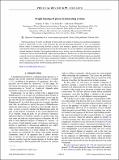| dc.contributor.author | Else, Dominic V. | |
| dc.contributor.author | Po, Hoi Chun | |
| dc.contributor.author | Watanabe, Haruki | |
| dc.date.accessioned | 2020-05-07T20:30:01Z | |
| dc.date.available | 2020-05-07T20:30:01Z | |
| dc.date.issued | 2019-03 | |
| dc.date.submitted | 2019-03 | |
| dc.identifier.issn | 2469-9950 | |
| dc.identifier.issn | 2469-9969 | |
| dc.identifier.uri | https://hdl.handle.net/1721.1/125124 | |
| dc.description.abstract | Topological phases of matter are defined by their nontrivial patterns of ground-state quantum entanglement, which is irremovable so long as the excitation gap and the protecting symmetries, if any, are maintained. Recent studies on noninteracting electrons in crystals have unveiled a peculiar variety of topological phases, which harbor nontrivial entanglement that can be dissolved simply by the the addition of entanglement-free, but charged, degrees of freedom. Such topological phases have a weaker sense of robustness than their conventional counterparts, and are therefore dubbed “fragile topological phases.” In this work, we show that fragile topology is a general concept prevailing beyond systems of noninteracting electrons. Fragile topological phases can generally occur when a system has a U(1) charge conservation symmetry, such that only particles with one sign of the charge are physically allowed (e.g., electrons but not positrons). We demonstrate that fragile topological phases exist in interacting systems of both fermions and of bosons. | en_US |
| dc.description.sponsorship | National Science Foundation (Grant PHY-1748958) | en_US |
| dc.publisher | American Physical Society (APS) | en_US |
| dc.relation.isversionof | http://dx.doi.org/10.1103/physrevb.99.125122 | en_US |
| dc.rights | Article is made available in accordance with the publisher's policy and may be subject to US copyright law. Please refer to the publisher's site for terms of use. | en_US |
| dc.source | American Physical Society | en_US |
| dc.title | Fragile topological phases in interacting systems | en_US |
| dc.type | Article | en_US |
| dc.identifier.citation | Else, Dominic V. et al. "Fragile topological phases in interacting systems." Physical Review B 99, 12 (March 2019): 125122 © 2019 American Physical Society | en_US |
| dc.contributor.department | Massachusetts Institute of Technology. Department of Physics | en_US |
| dc.relation.journal | Physical Review B | en_US |
| dc.eprint.version | Final published version | en_US |
| dc.type.uri | http://purl.org/eprint/type/JournalArticle | en_US |
| eprint.status | http://purl.org/eprint/status/PeerReviewed | en_US |
| dc.date.updated | 2019-03-15T18:00:15Z | |
| dc.language.rfc3066 | en | |
| dc.rights.holder | American Physical Society | |
| dspace.orderedauthors | Else, Dominic V.; Po, Hoi Chun; Watanabe, Haruki | en_US |
| dspace.embargo.terms | N | en_US |
| dspace.date.submission | 2019-04-04T15:53:22Z | |
| mit.journal.volume | 99 | en_US |
| mit.journal.issue | 12 | en_US |
| mit.license | PUBLISHER_POLICY | en_US |
| mit.metadata.status | Complete | |
